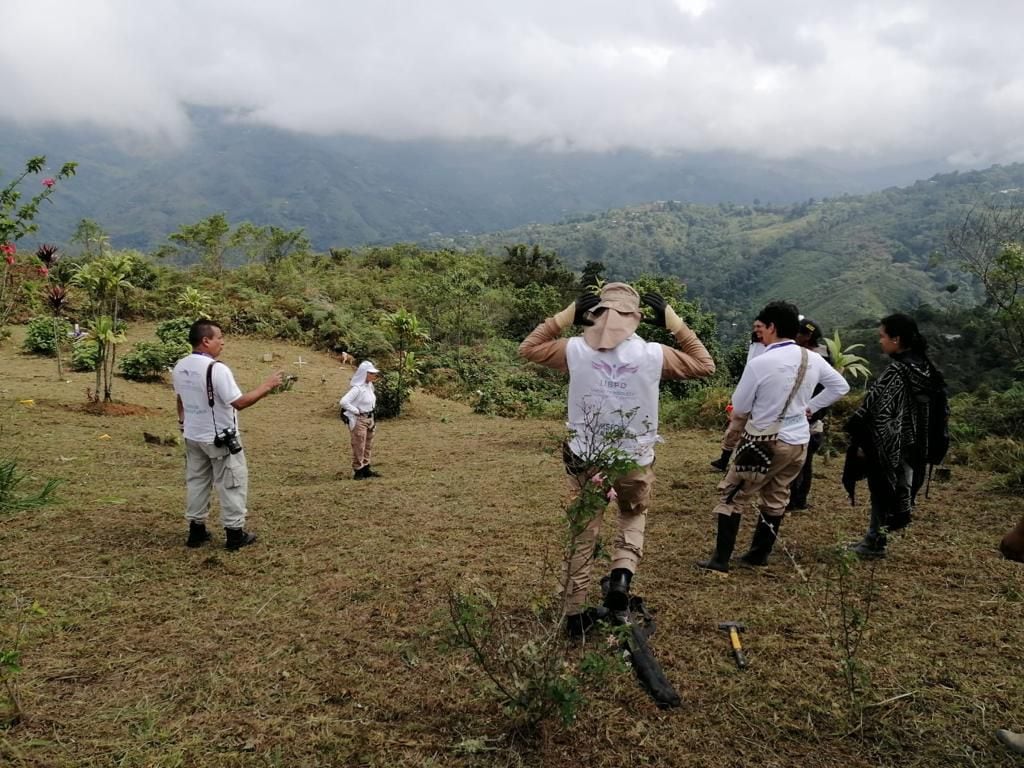
The Unit for the Search for Persons Disappeared (UBPD) reported on March 17 that in an evangelical cemetery in the village of El Tarso, located in the municipality of Caldono (Cauca), three bodies of persons allegedly disappeared in events related to the armed conflict between 1992 and 1994 were recovered.
Members of the community of the area participated in this humanitarian action, and there was also the support of the San Lorenzo de Caldono Indigenous Reservation and its indigenous guard, belonging to the Nasa people. This indigenous community, according to the Constitutional Court, is among the 34 indigenous peoples of Colombia who are at risk of forced displacement and cultural and social extinction due to the armed conflict.
During the framework of the armed conflict in Colombia, the communities of the municipalities of eastern Cauca buried hundreds of abandoned bodies that remained after the clashes between paramilitaries, guerrillas and public forces. With their handcrafted tools they made the burials and classified the bodies as N.N.
It may interest you: UBPD recovers the remains of eight unidentified people in the Urrao cemetery, Antioquia
According to the entity born of the Peace Agreement, one of the bodies could belong to the father of a 31-year-old man, who was present in the humanitarian action. In 2018 he arrived at UBP, requesting a search for the body, he would have also facilitated the location of the cemetery and provided important information to find other graves in the region. The Commons Party Search Commission also participated in the information-gathering process.
The recovered bodies were sent to the National Institute of Legal Medicine and Forensic Sciences in Cali to speed up the identification process. The UBPD Regional Search Plan Oriente del Cauca, which covers the municipalities of Caldono, Inza, Silvia, Totoró, San Lorenzo, Páez and Puracé, includes an initial universe of 177 persons reported missing, depending on the geographical, territorial and historical context of the armed conflict in this region of the country.
Between 1992 and 2004 in these municipalities, there were the highest peak of cases of disappearance, with 74 reports of persons forcibly missing, abducted and illicitly recruited, during this period.

According to data from the Single Registry of Victims, it is reported that 473,533 people are victims of the armed conflict in Cauca, that is, almost a third of the total departmental population. Violence was mainly concentrated in the municipalities of El Tambo, Algeria, Bolivar, Buenos Aires, López, Timbío, Guapi, Patía, Toribio and Sucre.
As is customary to the Unit, before the intervention in each cemetery or mass grave, it created educational spaces to explain the meaning of the process of prospecting or exploring the land and the importance of humanitarian and extrajudicial work for the search for persons missing due to the armed conflict.
It may interest you: Unit for Victims resumes the search and delivery of the bodies of victims of disappearance
This department has been one of the hardest hit by the war in Colombia. It became a strategic corridor by armed groups for the mobility of weapons and drugs to the departments of Cauca, Tolima and Valle del Cauca. According to the entity in Cauca, 2,041 people were reported missing.
The municipalities of Popayán, 232; Santander de Quilichao, 170; Patía, 136; El Tambo and Corinto, each with 114; Miranda, 104; Buenos Aires, 98; Algeria, 82; Caldono, 72; Cajibío, 67, and Toribío, 65, were the ones with the highest records.
KEEP READING:
Últimas Noticias
Debanhi Escobar: they secured the motel where she was found lifeless in a cistern
Members of the Specialized Prosecutor's Office in Nuevo León secured the Nueva Castilla Motel as part of the investigations into the case

The oldest person in the world died at the age of 119
Kane Tanaka lived in Japan. She was born six months earlier than George Orwell, the same year that the Wright brothers first flew, and Marie Curie became the first woman to win a Nobel Prize

Macabre find in CDMX: they left a body bagged and tied in a taxi
The body was left in the back seats of the car. It was covered with black bags and tied with industrial tape
The eagles of America will face Manchester City in a duel of legends. Here are the details
The top Mexican football champion will play a match with Pep Guardiola's squad in the Lone Star Cup

Why is it good to bring dogs out to know the world when they are puppies
A so-called protection against the spread of diseases threatens the integral development of dogs




